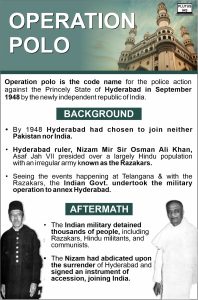15 Sep Operation Polo
This article covers “Daily Current Affairs” and the Topic details “Operation Polo”. This Topic has relevance in the Modern History section of the UPSC CSE exam.
For Prelims:
Facts about Operation Polo?
For Mains:
GS 1: Modern History
Process of Integration?
Why in the news
September 13, 2023, commemorates the 75th anniversary of Operation Polo, a significant military operation initiated by the Indian Army on September 13, 1948, aimed at integrating the princely state of Hyderabad into the Indian Union.
Background:
Hyderabad State, ruled by the Nizam Mir Osman Ali Khan, was one of the largest princely states in British India. Despite its predominantly Hindu population, the Nizam, a Muslim ruler, sought to maintain Hyderabad’s independent status as India gained independence in 1947.
Controversial Status:
The Nizam’s desire for independence clashed with the Hindu majority’s aspiration to merge with the Indian Union. This conflict was exacerbated by communal tensions, particularly between the Hindu majority and the Muslim ruling elite represented by the Razakars, a private militia accused of committing atrocities against Hindus. These events fueled the demand for Hyderabad’s integration into India.
Sardar Patel’s Diplomacy:
Initially, the Indian government, led by Sardar Vallabhbhai Patel, attempted peaceful negotiations to integrate Hyderabad. However, the Nizam’s reluctance and the deteriorating communal situation thwarted these efforts.
Operation Polo:
Operation Polo was initiated due to the Nizam of Hyderabad’s desire to maintain his state’s independence following India’s independence in 1947. The Nizam exploited India’s focus on the Kashmir conflict with Pakistan, diverting resources and attention away from Hyderabad. In November 1947, a standstill agreement was signed between the Nizam and India, postponing Hyderabad’s immediate integration into India for a year while maintaining existing conditions.
Several factors prompted the launch of Operation Polo on September 13, 1948:
- Escalating Tensions: During the standstill agreement period, the Nizam’s administration in Hyderabad bolstered the Razakars, an irregular force led by Maj Gen SA El Edroos, which targeted the predominantly Hindu population in the state.
- Border Incursions: The Razakars engaged in cross-border raids, causing tensions along Hyderabad’s borders.
- Overtures to Pakistan: The Nizam hinted at the idea of establishing an independent entity within India’s borders by making diplomatic overtures to Pakistan.
- Threat of Secession: The Nizam’s actions, along with the presence of the Razakars, raised concerns about Hyderabad attempting to secede from India, posing a threat to India’s unity.
- In response, the Indian government took “Police Action” to prevent Hyderabad’s secession and ensure its integration into India. The Nizam’s forces numbered fewer than 25,000, with only a fraction being well-trained. Although the Razakars were numerous, they were not a formidable military opposition.
- Hyderabad’s resistance crumbled within the first two days of Operation Polo, which was primarily conducted by Maj Gen Jayanto Nath Chaudhuri’s 1 Armoured Division, with additional thrusts from the north, south, and east of the state.
- Operation Polo achieved success,Recognising the futility of resistance, the Nizam surrendered on September 17, 1948, by signing an Instrument of Accession, officially integrating Hyderabad into the Indian Union.
Aftermath:
Operation Polo marked the end of princely rule in India and led to the reorganization of Hyderabad into Andhra Pradesh, along with portions in Maharashtra and Karnataka. Many Razakars and Nizam’s government officials were arrested and tried for their roles in the conflict. The operation’s legacy remains a subject of historical debate, with some criticizing the use of force while others argue it was necessary to prevent further communal violence and secure Hyderabad’s integration into India.
Cultural Integration:
Hyderabad’s integration into India brought together people from diverse linguistic, religious, and cultural backgrounds, initiating a process of cultural assimilation and integration.
Conclusion:
Operation Polo played a pivotal role in India’s early post-independence history, facilitating the integration of Hyderabad into the Indian Union. It was a multifaceted event marked by political, religious, and cultural tensions, leaving a lasting impact on the region’s history and the broader narrative of Indian unity.

SOURCE:https://indianexpress.com/article/research/hyderabad-liberation-day-operation-polo-nizam-5361186/
Download plutus ias current affairs eng med 15th Sep 2023
Q.1 “Operation Polo” is related to:
(a) Ascension of Hyderabad
(b) Liberation of Goa
(c) Assimilation of Sikkim
(d) Integration of Junagadh
Q.2 Consider the following statements regarding Operation Polo and integrating Hyderabad into the Indian Union:
- Operation Polo was initiated due to the Nizam’s desire to integrate with Pakistan.
- Hyderabad’s integration into India led to its reorganization into Andhra Pradesh, parts of Maharashtra, and Karnataka.
Which of the statements given above is/are correct?
(a) 1 only
(b) 2 only
(c) Both 1 and 2
(d) Neither 1 nor 2
Q.3 Discuss the challenges and strategies employed by the Indian government in integrating princely states into the Indian Union after gaining independence in 1947. How did this process impact India’s territorial integrity, governance, and nation-building efforts?




No Comments